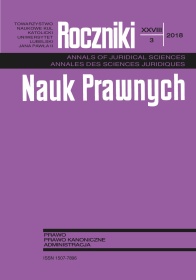The Protection of Client’s Interests, as Arising from the Right (Requirement) to Rely On Legal Professional Privilege in China, Compared to Polish Solutions – the Development of the System. Part III
The Chinese Model of Mutual Relations between the Attorney and the Client until 1949
Abstract
The Protection of Client’s Interests, as Arising from the Right (Requirement) to Rely On Legal Professional Privilege in China, Compared to Polish Solutions – the Development of the System. Part III. The Chinese Model of Mutual Relations between the Attorney and the Client until 1949
The process of developing legal profession, as well as relations between the attorney and the client in China was significantly delayed and only began to exist in the beginning of the 20th century, in comparison to Europe. This legal institution has a crucial importance for the Western legal culture and it appeared in China thousands of years later for various reasons. The most important of them was undoubtedly the conflict between the philosophical schools and the legists, which led to the lawyers’ defeat. Consequently, it created a marginalization of their role in China for the next two millennia. Hence, the main reason for the public distrust against the jurists, which have had not been overcome until the modern times.
References
Bednaruk, Waldemar. 2012. “O przyczynach pieniactwa w szlacheckim narodzie.” Palestra 3–4: 205–213.
Blazey, Patricia, and Gisele Kapterian. 2008. “Traditional Chinese Law.” In Commercial Law of the People’s Republic of China, edited by Patricia Blazey, 19–55. Australia: Thomson Reuters Press.
Conner, Alison W. 2009. “China’s Lawyers and Their Training: Enduring Influences and Disconnects.” Legal Development in East Asia: China and Vietnam Compared, Forthcoming, in: https://ssrn.com/abstract=1433602 [access: 24.07.2018].
Dargas, Marta. 2012. “W jakim kierunku zmierza prawo Chińskiej Republiki Ludowej – ku systemowi common law czy ku kompleksowej kodyfikacji prawa?.” Gdańskie Studia Azji Wschodniej 1:59–68.
Dillon, Michael. 2012. Chiny. Historia współczesna, translated by Leszek Otrębski. Warszawa: Wydawnictwo Książka i Wiedza.
Fairbank, John K. 2004. Historia Chin. Nowe spojrzenie. Warszawa–Gdańsk: Wydawnictwo Marabut.
Fitzgerald, Charles P. 1974. Chiny. Zarys historii kultury. Warszawa: Państwowy Instytut Wydawniczy.
Kania, Małgorzata. 2012. “Wpływ konfucjanizmu na kształtowanie się systemu prawa w Chinach.” In Acta Erasmiana II. Prace z myśli polityczno-prawnej oraz prawa publicznego, edited by Mirosław Sadowski, and Piotr Szymaniec, 183–194. Wrocław: Wydział Prawa, Administracji i Ekonomii Uniwersytetu Wrocławskiego.
Kość, Antoni. 1998. Prawo a etyka konfucjańska w historii myśli prawnej Chin. Lublin: Pracownia Poligraficzna przy Prywatnym Katolickim Liceum Ogólnokształcącym.
Kość, Antoni. 2000. “Rozwój prawa w czasie Republiki Chińskiej (1912-1949).” Czasy Nowożytne 9(10):127–135.
Rodziński, Witold. 1974. Historia Chin. Wrocław: Zakład Narodowy im. Ossolińskich.
Sidichmienow, Wasilij. 1990. Ostatni cesarze Chin, translated by Jerzy Abkowicz, and Roman Sławiński. Katowice: Wydawnictwo Śląskie.
Szang, Jüe (edited by). 1960. Dzieje Chin. Zarys, translated by Witold Rodziński. Warszawa: Wydawnictwo PWN.
Wang, Chang, and Nathan H. Madson. 2013. Inside China’s Legal System. Oxford: Chandos Publishing.
Zhang, Lihong. 2014. “Prawo porównawcze w Chinach.” Forum Prawnicze 5(25):3–15.
Zimmerman, James M. 2005. China Law Deskbook: A Legal Guide for Foreign – invested Enterprises. Chicago: American Bar Association.
Copyright (c) 2018 Roczniki Nauk Prawnych

This work is licensed under a Creative Commons Attribution-NonCommercial-NoDerivatives 4.0 International License.


